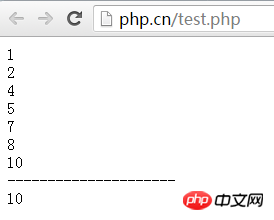
The so-called Callback function means that when calling a function, instead of passing a standard variable as a parameter, another function is passed as a parameter to the called function. If callback type parameters appear in the format description of the function, the function is a callback function. The previous section introduced php variable parameter functions, this section will get into the study of PHP callback functions.
The format description of the callback function is as follows:
mixed funName (callback arg) //在参数列表中使用伪类型 callback 描述
callback is also a type of pseudo-type in PHP, indicating that the parameters of the function need to accept another function as an actual parameter. A very important question is why use functions as parameters? As introduced before, the execution behavior of the calling function can be changed by passing parameters, but sometimes the ability to only pass a value to the function is still limited. If a user-defined execution process can be passed to the function for use, it greatly increases the user's expansion of the function functionality. How to declare and use callback functions is also a critical issue. If you need to declare a callback function, you need to first understand the variable function.
Variable function
Variable function is also called variable function. If a variable name is followed by parentheses, PHP will look for a function with the same name as the variable's value and will attempt to execute it. For example, declare a function test() and assign the function name string test to the variable $demo. If you print the $demo variable directly, the output value must be the string test; but if you add parentheses $demo() after the $demo variable, the function corresponding to the $demo variable value test is called. In this way, different function names can be assigned to the same variable, and then the function can be called through the variable, which is similar to the application of polymorphic features in object-oriented.
The example code is as follows:
<?php
function one($a,$b){
return $a + $b;
}
function two($a,$b){
return $a*$b;
}
function three($a,$b){
return $a/$b;
}
$result = "one"; //将函数名one赋值给变量$result,执行$result()时则调用函数one()
//$result = "two"; //将函数名two赋值给变量$result,执行$result()时则调用函数two()
//$result = "three"; //将函数名three赋值给变量$result,执行$result()时则调用函数three()
echo "结果是:".$result(4,6); //变量$result接收到哪个函数名的值,就调用哪个函数
?>In the above example, three functions one(), two() and three() are declared, using Used to calculate the sum, product and quotient of two numbers. And assign the function names of the three functions (without parentheses) to the variable $result as a string, then use the variable name $result followed by parentheses and pass in two integer parameters, it will Finds the function execution with the same name as the value of variable $result. Most functions can assign the function name to a variable to form a variable function. But variable functions cannot be used in language structures.
Use variable functions to declare and apply callback functions
If you want to customize a function that can be called back, you can choose to use variable functions Help achieve. When defining a callback function, the declaration structure of the function does not change, as long as the declared parameter is an ordinary variable. But when applying this parameter variable inside a function, if you add parentheses, you can call the function with the same name as the parameter value, so the parameter passed must be the name string of another function. The purpose of using the callback function is to pass a self-defined function to the function for use inside.
The code example is as follows:
<?php
//声明回调函数filter, 在0-10的整数中通过自定义条件过滤不要的数字
function filter($fun){
for($i=0; $i<=10; $i++){
//将参数变量$fun加上一个圆括号$fun(),则为调用和变量$fun值同名的函数
if($fun($i))
continue;
echo $i.'<br>';
}
}
//声明一个函数one,如果参数是3的倍数就返回ture,否则返回false
function one($num){
return $num%3 == 0;
}
//声明一个函数two,如果参数是一个回文数返回ture,否则返回false
function two($num){
return $num == strrev($num);
}
filter("one"); //打印出10以内非3的倍数,参数one是函数one()的名称字符串,是一个回调
echo "---------------------<br>";
filter("two"); //打印出10以内非回文数,参数two是函数two()的名称字符串,是一个回调
?>The result of running is:

In the above example , if the declared function filter() only accepts ordinary values as parameters, the number that the user can filter out will be relatively single. In this example, in the defined function filter(), a tax-containing value passed in as a filter condition is called. In this way, the function is much more powerful. You can filter out any numbers you don’t like in the filter() function. . By adding a parenthesis $fun() to the parameter variable $fun inside the function filter(), you can call a function with the same value as the variable $fun as a filtering condition. For example, in this example, two functions one() and two() are declared, which are used to filter out multiples and palindromes of 3 within 10 respectively. As long as the function names one and two are strings when calling filter() Passed to parameters, that is, these two functions are passed to the filter() function for internal use.
This chapter explains the variable function definition, declaration and application of the php callback function. In the next chapter we will introduce the call_user_func_array() function of the php callback function and its usage.
【Recommended related tutorials】
1. "php.cn Dugu Jiujian (4)-php video tutorial"
2. php programming from entry to master a full set of video tutorials
3. php practical video tutorial
The above is the detailed content of PHP function callback function (1) Variable function definition, declaration and application. For more information, please follow other related articles on the PHP Chinese website!




